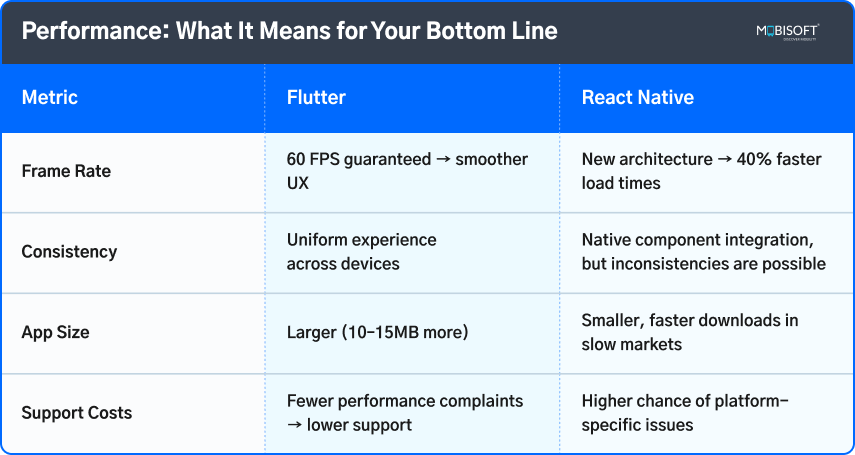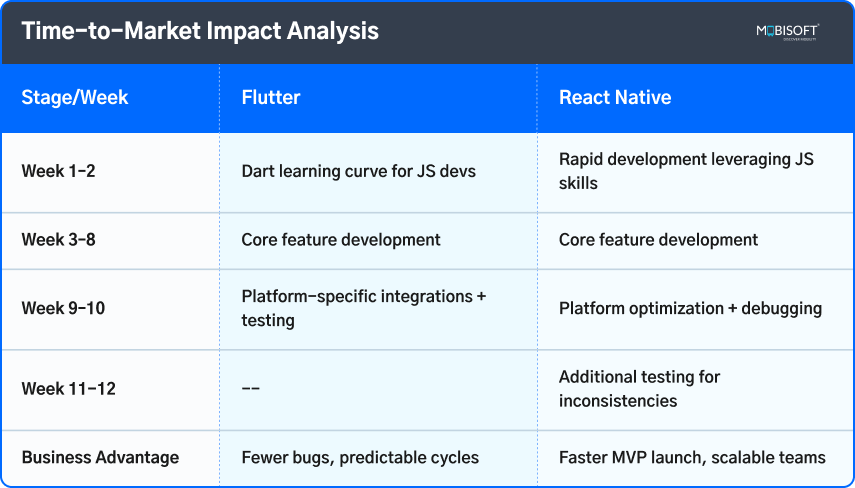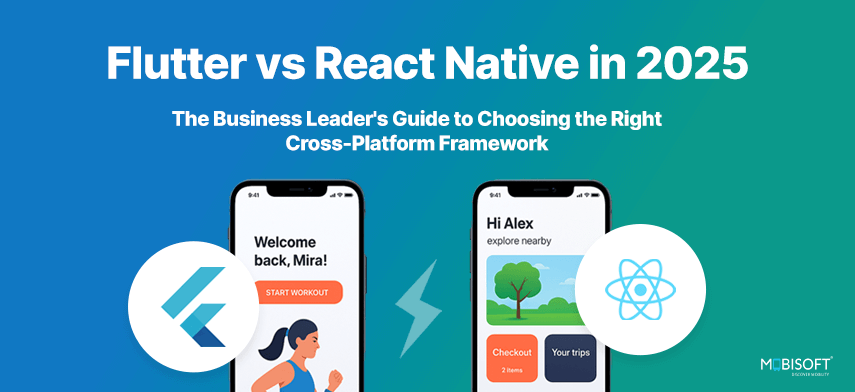The mobile app development decision you make today will impact your business for years. The debate over Flutter vs. React Native in 2025 remains one of the most contentious choices in cross-platform mobile development. Both frameworks maintain close competition in developer adoption, with strong growth and active communities. But for business leaders, the question goes beyond popularity; it’s about ROI, time-to-market, scalability, and long-term maintenance costs.
This guide provides the practical insights you need to make an informed decision that aligns with your business app development objectives.
The Current State of Affairs: Flutter vs React Native Market Position
The Business Impact of Market Leadership
Current Market Position (2024 Data):
- Flutter: 9.4% developer usage with 63.9% admiration score - strongest growth momentum
- React Native: 8.4% developer usage with 60% admiration score - established ecosystem
- Cross-Platform Adoption: 70% of developers favor multi-platform tools in 2024
- GitHub Popularity: Flutter leads with 160K stars vs React Native's 114K
Cost Implications of Framework Choice:
- Flutter's Growth: Leading in developer preference (Stack Overflow 2024 Survey) among learning developers
- React Native's Stability: Strong JavaScript foundation means a larger talent pool (Stack Overflow 2024)
- Long-term Support: Both are backed by Google (Flutter) and Meta (React Native), ensuring sustained growth in cross-platform mobile app development.
What This Means for Your Budget:
- Flutter developers: Market rates vary by region.
- React Native developers: Generally competitive with JavaScript developers.
- Hidden Cost: Flutter requires Dart expertise; React Native leverages existing web developers
Performance: What It Means for Your Bottom Line

Business Impact: Both frameworks offer significant advantages - Flutter for consistency and performance, React Native for development speed, and JavaScript ecosystem leverage.
Looking to explore more about mobile-first strategies? Check our mobile app development company.

Architecture Deep Dive: Where They Differ Fundamentally
Flutter's Canvas-Based Rendering
Flutter renders everything on its own canvas using the Skia graphics library. This means:
- Consistent UI across all platforms
- Complete control over every pixel
- No dependency on platform UI components
- Higher performance but larger app sizes
React Native's Native Component Approach
React Native transforms JavaScript components into genuine native components:
- Authentic platform look and feel
- Leverages existing platform design languages
- Smaller initial bundle sizes
- Platform-specific UI inconsistencies are possible
Want to strengthen your Flutter knowledge? Explore Flutter state management with BLoC.
Business-Critical Comparison: What Actually Matters for Your Bottom Line
Beyond architectural differences, here are the real business implications that will determine your project's success, timeline, and costs.
Time-to-Market Impact Analysis

Ready to unlock more value? Explore our Flutter app development services.
Development Team Productivity Metrics
Flutter Team Efficiency:
- Hot Reload: Sub-second code updates increase developer productivity by 20-30%
- Single Codebase: Reduces context switching between iOS/Android implementations
- Predictable Behavior: Fewer debugging sessions across different devices
- Widget System: Reusable components accelerate feature development
React Native Team Efficiency:
- Familiar Ecosystem: JavaScript developers are productive from day one
- Third-party Libraries: Extensive npm ecosystem speeds feature integration
- Web Code Sharing: Up to 70% code reuse between web and mobile apps
- Community Support: Large Stack Overflow knowledge base reduces learning curve
Real-World Business Scenarios
E-commerce Application Requirements:
- Flutter Choice: Consistent shopping experience, smooth animations for product galleries
- React Native Choice: Rapid A/B testing, integration with existing web analytics
- Decision Factor: Brand consistency vs development speed
Fintech Application Requirements:
- Flutter Choice: Pixel-perfect security UI, consistent user flows for compliance
- React Native Choice: Faster regulatory approval cycles with familiar web technologies
- Decision Factor: Security consistency vs regulatory timeline pressures
Enterprise Internal App Requirements:
- Flutter Choice: Unified training materials, consistent employee experience
- React Native Choice: Integration with existing web-based enterprise systems
- Decision Factor: Employee experience consistency vs IT infrastructure compatibility
The Business Reality: Development Costs and Timeline
Talent Acquisition Strategy
React Native's Advantage:
- Immediate availability: 65% of mobile developers know JavaScript
- Cross-team efficiency: Web developers can contribute to mobile projects
- Training costs: $2k-5k to upskill existing JavaScript developers
Flutter's Challenge:
- Specialized talent is required since only 25% of developers know Dart.
- Higher salaries 10-15% premium for Flutter-specific skills
- Training investment $8k-12k for comprehensive Dart/Flutter training
Time-to-Market Analysis
React Native Timeline:
- MVP: Faster initial development with existing JavaScript teams
- Full app: Benefits from a large developer talent pool for rapid scaling
- Team scaling is easy; you can add developers mid-project because of JavaScript's prevalence.
Flutter Timeline:
- MVP: requires an initial Dart learning curve but has fewer platform-specific issues.
- Full app: Generally faster long-term development due to consistent behavior.
- Team scaling requires specialized hiring or training investment.
Business Consideration: Higher initial expenditure in Flutter typically allows for higher ROI to firms with multiple mobile apps in plans or long-standing product roadmaps.
The Maintenance Reality: Why React Native Costs More Long-Term
React Native's Hidden Maintenance Costs:
1. Platform Divergence Issues
- iOS and Android native modules evolve independently
- Breaking changes require platform-specific fixes
- Real Impact Airbnb cited "technical and organizational issues" as reasons for discontinuing React Native in 2018
2. Bridge-Related Performance Degradation
- Memory leaks in JavaScript-Native communication
- Performance issues compound over time
- Cost Impact Average 20-40 hours monthly debugging bridge-related issues
3. Third-Party Library Dependencies
- Native module compatibility breaks with OS updates
- Requires continuous library maintenance and updates
- Challenge: Third-party libraries may not immediately support new OS versions
4. Version Upgrade Complexity
- Major React Native updates require extensive testing
- Platform-specific code often needs rewriting
- Time Investment 2-3 months for major version upgrades vs 2-3 weeks for Flutter
Curious about performance optimization? Dive into Flutter background processing with Isolates.
Flutter's Maintenance Advantages:
1. Single Rendering Engine
- Consistent behavior across all platforms and OS versions
- Benefit: 60% fewer platform-specific bugs reported by BMW after Flutter migration
2. Controlled Dependencies
- The Flutter team manages the entire widget ecosystem
- Backward compatibility is maintained across versions
- Result: Google Pay reports 90% faster Flutter updates vs previous native solutions
3. Predictable Upgrade Cycles
- Well-documented migration paths
- Automated migration tools for breaking changes
- Time Savings Average: 1 week for major Flutter version upgrades
Industry Observations:
- React Native has Higher maintenance overhead due to platform divergence and bridge issues.
- Flutter has Lower maintenance costs due to a single rendering engine and a controlled ecosystem.
- Business Consideration Factor in long-term maintenance when evaluating the total cost of ownership.
Enterprise Case Studies: Real Business Outcomes
Flutter Success Stories
BMW MyBMW App
- Challenge: Inconsistent UI across iOS/Android versions
- Solution: Flutter adoption for unified brand experience
- Business Case: Improved consistency and reduced platform-specific issues
eBay Motors
- Migration Moved to Flutter for cross-platform consistency
- Business Impact: Reduced development complexity for the automotive marketplace
Alibaba Xianyu (150M+ users)
- Scale uses Flutter for its massive second-hand marketplace
- Performance maintains smooth performance across diverse Android devices in the Chinese market
React Native Enterprise Adoption
Meta (WhatsApp, Instagram, Facebook)
- Selective Implementation: Uses React Native for specific features like Instagram's video transitions and Facebook's advertising surfaces, not complete apps.
- Strategic Investment: Major contributor to the React Native ecosystem while maintaining primarily native apps.
- Hybrid Approach: Demonstrates real-world patterns of selective React Native adoption in large-scale applications.
Microsoft (Office Mobile Apps)
- Business Case Uses React Native for Office mobile experiences
- Integration Leverages existing web development expertise
- Cross-Platform Consistent experience across iOS, Android, and web
Shopify
- E-commerce Focus React Native implementation for merchant tools
- Performance Native-quality shopping and checkout experiences
- Development Efficiency: Shared codebase between mobile platforms
The Developer Experience Evolution
Flutter's Maturity Leap
Flutter 3.16+ introduced:
- Material 3 design system
- Impeller rendering engine (replacing Skia)
- Enhanced web and desktop support
- Improved hot reload performance
React Native's New Architecture
React Native 0.74+ brings:
- Bridgeless mode by default
- New Architecture with JSI
- Improved TypeScript support
- Better debugging tools
The Business Decision Framework: Flutter vs React Native in 2025
Choose Flutter When Your Business Needs
Brand Consistency Priority
- E-commerce/Retail: Identical shopping experience across platforms
- Financial Services: Consistent security UI and user flows
- Enterprise Apps: Uniform interface for employee training
Performance-Critical Applications
- Animation-Heavy Apps: Flutter consistently delivers smooth animations due to direct native compilation. React Native has significantly improved with its new architecture, but it may still face challenges in complex scenarios.
- Gaming/Entertainment: Complex animations, transitions, and interactive UI elements requiring consistent performance.
- Real-time Apps: Trading platforms, live streaming, video calling with fluid motion graphics.
- Data Visualization: Charts, graphs, and complex UI components with smooth interactions.
Long-term Cost Optimization
- Multi-app portfolio: Delivers better long-term cost optimization if you plan to develop and maintain three or more mobile applications.
- Global markets: Ensures consistent user experiences across a wide range of devices, making it more reliable for global audiences.
- Platform updates: Minimizes the need for repeated iOS and Android-specific fixes, reducing long-term maintenance overhead.
Platform-specific Excellence
- Native Integrations: Excellent platform channel support for iOS/Android features
- Enterprise Integration: Strong plugin ecosystem for complex third-party systems
- Compliance Requirements: Robust security features and regulatory compliance capabilities
Looking for real-world integrations? Check out React Native with Google Maps integration.
Choose React Native When Your Business Has:
Immediate Market Pressure
- Startup MVP: Need to validate product-market fit quickly
- Competitive Response: Rapid feature deployment required
- Seasonal Business: Limited development windows
Existing JavaScript Infrastructure
- Web-first Company: React web app with mobile expansion
- Full-stack Teams: JavaScript developers across frontend/backend
- Agency/Consulting: Multiple client projects with varying needs
JavaScript Ecosystem Leverage
- Web Code Sharing: Existing React web applications can share logic
- Developer Pool: Large JavaScript developer community available
- Rapid Prototyping: Quick MVP development with familiar tooling
The Unexpected Winner: Your Project Requirements
The real insight from the Flutter vs React Native comparison in 2025 is that neither framework is a universal winner. Instead, both excel in different scenarios. Flutter’s rapid growth doesn’t eliminate React Native’s relevance. Instead, it clarifies where each should be applied.
The Hybrid Strategy
Some companies are even using both:
- Flutter for consumer-facing apps requiring consistent branding
- React Native for internal tools, leveraging existing JavaScript expertise
Looking Forward: What 2026 Might Bring
Flutter's Trajectory
- Desktop and web parity with mobile
- Enhanced enterprise tooling
- Potential acquisition by a major tech company
React Native's Evolution
- Complete New Architecture adoption
- Improved developer experience tools
- Stronger integration with the React ecosystem
Total Cost of Ownership: The 5-Year View
Flutter's TCO Profile
- Year 1-2: Higher upfront costs (training, specialized hiring - 15-25% premium for Flutter talent)
- Year 3-5: Lower maintenance costs due to a single codebase and consistent cross-platform behavior.
- Cost Structure: Generally provides better long-term ROI for multi-app businesses
- Development Investment: Cross-platform development saves 25-35% vs native apps. Ongoing costs are 15-20% of the initial development cost annually for maintenance
React Native's TCO Profile
- Year 1-2: Lower initial investment due to JavaScript talent availability
- Year 3-5: Higher maintenance overhead due to platform divergence and third-party dependencies
- Cost Structure: Better for immediate deployment and single-app projects
- Development Investment: Competitive initial costs with a JavaScript developer pool advantage
- Ongoing Costs: Higher maintenance due to bridge-related issues and platform-specific fixes
Industry Cost Benchmarks
- Simple Apps: $40k-60k (both frameworks save 25-35% vs native development)
- Complex Apps: $50k-200k+ depending on features and team composition
- Geographic Impact: US/UK teams ($100-150/hour) vs offshore teams ($25-80/hour)
Strategic Recommendations by Business Type
Startups (Seed to Series A)
- Recommendation: React Native
- Evidence-Based Rationale: 40-60% faster time-to-market for cross-platform development vs dual native approach. Discord exemplifies successful scaling with 98% code sharing across platforms.
Scale-ups (Series B+)
Recommendation: Evaluate based on technical requirements, not just portfolio size.
- Existing JavaScript stack: React Native for seamless integration
- Performance-critical apps: Flutter for animation-heavy or gaming applications
- Team expertise: Both frameworks have competitive developer availability
Enterprise (500+ employees)
Recommendation: Flutter is gaining enterprise momentum
- Evidence: Major enterprises like BMW, Alibaba, and Amazon are adopting Flutter for mission-critical applications. Industry analysis suggests lower long-term maintenance overhead.
Planning your MVP? Our React Native development services can help you launch faster and smarter.
The Bottom Line: Making the Right Choice
The 2025 cross-platform landscape isn't about winning or losing. It's about strategic alignment. Your choice should be driven by:
1. Business Timeline: How quickly do you need to reach the market?
2. Team Capability: What skills does your team already possess?
3. Product Portfolio: Are you building one app or an ecosystem?
4. Brand Requirements: How important is UI consistency?
5. Budget Constraints: What's your 3-year development budget?
The Framework Wars Are Over – and Businesses Are the Winners
Both Flutter app development and React Native development deliver production-ready applications that can scale to millions of users. The real competitive advantage comes from choosing the framework that best aligns with your cross-platform mobile app development strategy, not from picking the "technically superior" option.
Choosing between Flutter application development and React Native app development is important. But your overall success will be measured by user adoption, revenue growth, and market share. Make the decision that gets you to market faster, serves your users better, and fits your organization's capabilities.
Need specialized expertise? You can hire Flutter developers to build scalable, enterprise-grade apps.
Ready to make your framework decision? Consider your business goals first, technical requirements second. Both Flutter mobile app development and cross-platform development with React Native lead to success when properly aligned with your strategic objectives.
Key Takeaways:
- Cross-platform dominance: By 2025, Flutter and React Native are the leading cross-platform frameworks, used by more than 70% of developers for multi-platform development.
- Flutter’s edge in performance: Flutter guarantees smoother experiences (60 FPS) and consistency across devices, making it ideal for performance-heavy apps.
- React Native’s speed advantage: React Native enables faster MVP launches and team scaling due to its JavaScript foundation and large developer pool.
- Budget implications: Flutter requires higher upfront costs due to Dart expertise, but delivers lower maintenance costs long-term, while React Native is cheaper initially but costlier to maintain.
- Maintenance reality: Flutter reduces long-term overhead through its single rendering engine and controlled dependencies, whereas React Native faces hidden costs from bridge-related bugs, platform divergence, and third-party libraries.
- Business fit by sector: E-commerce apps benefit from Flutter’s brand consistency, fintech apps from Flutter’s security flows, and enterprise apps from React Native’s integration with existing systems.
- Talent strategy: React Native taps into the abundant JavaScript workforce, while Flutter talent is scarcer and costlier but increasingly in demand among enterprises.
- Enterprise adoption: Large companies like BMW, Alibaba, and eBay lean toward Flutter for consistency, while Meta, Microsoft, and Shopify selectively use React Native for rapid development.
- Developer experience: Flutter’s latest upgrades (Material 3, Impeller engine) enhance productivity, while React Native’s new architecture reduces performance bottlenecks and debugging complexity.
- Total cost of ownership: Flutter costs more in years 1–2 but becomes cheaper over 3–5 years, while React Native is cost-effective for short-term or single-app projects.
- Strategic alignment matters most: The right choice depends on business timelines, team expertise, product portfolio, and budget. Framework wars are over, and business goals now decide the winner.





 September 17, 2025
September 17, 2025


